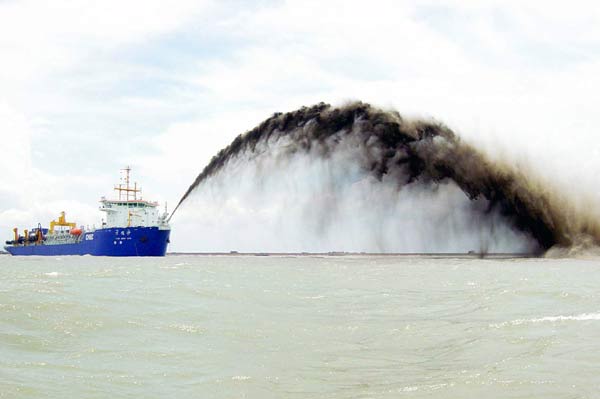CDSR dredging hoses are usually used to transport sand, mud and other materials in offshore dredging projects, connected to a dredging vessel or equipment to transfer sediment to a designated location through suction or discharge. Dredging hoses play an important role in port maintenance, marine engineering construction, river dredging and other fields, providing strong support for maintaining smooth waterways and environmental protection of waters.
Frequency Calculation
Dredging cycle: Dredging cycle refers to the time interval required to conduct a dredging operation. According to the characteristics of the port or waterway and the changes in water depth, a corresponding dredging cycle will generally be formulated.
Data analysis: Analyze the trends and rates of sedimentation in ports or waterways based on historical dredging records, hydrological data, sediment movement and other data.
Dredging method: According to the material characteristics and the technical capabilities of the dredging equipment, select the appropriate dredging method and process to determine the project volume and operation efficiency.
The calculation result of dredging frequency is an estimated value, and the specific value needs to be adjusted based on actual conditions and engineering requirements. At the same time, the calculation of dredging frequency also needs to be continuously monitored and updated to ensure that the navigation conditions of the port or waterway meet the requirements.

Recommended dredging frequency
Shallow draft channels (less than 20 feet) may undergo maintenance dredging every two to three years
Deep draft channels (not less than 20 feet) may undergo maintenance dredging every five to seven years
Factors affecting dredging frequency
Geographical environment: The undulations of the seafloor topography and changes in water depth will cause the accumulation of sediments, forming silt, sandbars, etc. For example, sea areas near river mouths are prone to silt areas due to the large amount of sediment transported by rivers. While sandbars are easily formed in the sea near coastal islands. These geographical conditions will lead to siltation of the waterway, requiring regular dredging to keep the waterway clear.
Minimum depth: The minimum depth refers to the minimum water depth that must be maintained in a channel or port, which is usually determined by the draft of the ship and navigation safety requirements. If seabed sedimentation causes the water depth to fall below the minimum depth, it may increase the risks and difficulties for ship passage. In order to ensure the navigability and safety of the channel, the frequency of dredging needs to be frequent enough to maintain the water depth above the minimum depth.
Depth that can be dredged: Depth that can be dredged is the maximum depth of sediment that can be effectively removed by dredging equipment. This depends on the technical capabilities of the dredging equipment, such as the digging depth limit of the dredge. If the sediment thickness is within the dredable depth range, dredging operations can be performed to restore the appropriate water depth.
How quickly sediment fills the area: The rate at which sediment fills the area is the rate at which sediment accumulates in a specific area. This depends on water flow patterns and sediment transport speeds. If sediment fills quickly, it may cause the channel or port to become impassable in a shorter period of time. Therefore, the appropriate dredging frequency needs to be determined based on the sediment filling rate to maintain the required water depth.
Date: 08 Nov 2023





 中文
中文